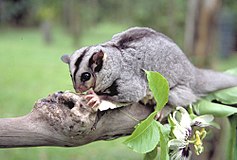Girramay National Park
| Girramay National Park | ||
|---|---|---|
| Gleithörnchenbeutler ( Petaurus gracilis ) | ||
|
|
||
| Location: | Queensland , Australia | |
| Specialty: | Rainforest, mangroves | |
| Next city: | 12 mile (s) from Cardwell | |
| Surface: | 337.30 km² | |
| Founding: | 2007 | |
| Cassowary ( Casuarius casuarius ) | ||
The Girramay National Park (English Girramay National Park ) is a 295 km² national park in Queensland , Australia . Since 1988 it has been listed as a UNESCO World Heritage Site Wet Tropics of Queensland because of its natural beauty, biological diversity , evolutionary history and as a habitat for numerous endangered animal species . The western part of the park, the Murray Falls section, is also part of the Wooroonooran Important Bird Area , which is home to numerous endemic bird species. It is characterized by lush rainforest and numerous waterfalls. The eastern part, the Edmund Kennedy section, extends along the Coral Sea and consists mainly of swamps and extensive mangrove forests .
history
The Girramy Aboriginal tribe have lived in this region for thousands of years; they are the namesake of the park. The Girramay National Park was designated on July 20, 2007, the two sections were connected on June 5, 2009, whereby the eastern part was listed under the name Edmund Kennedy National Park up to this point in time.
location
The park is located in the North Queensland region and is approximately 20 km northwest of Cardwell and 35 km south of Tully . The Murray Falls section borders immediately to the north on the Koombooloomba , in the west on the Kirrama and in the south on the Girringun National Park . The Edmund Kennedy section is accessible from the Bruce Highway via Clift Road, the junction is about 3 km north of Cardwell. The Murray Falls section is accessed via a 20 km long access road, which also branches off to the east from the Bruce Highway near Murrigal .
Murray Falls section
The waterfalls on the upper reaches of the Murray River are the main attraction of the 215 km² eastern part of the national park (formerly: Murray Upper National Park ). Located at the foot of the Kirrama mountain range, the river plunges in several cascades over granite rocks formed by the water towards the valley. In addition to a simple hike to the waterfalls, there is also the opportunity to explore the lush rainforest on the Yalgay Ginja Bulumi path. Here you can observe a variety of animals, including wallabies , possums, but also reptiles and amphibians , including the endangered Taudactylus acutirostris from the Australian southern frog family and the also endangered Litoria nyakalensis from the tree frog family . The cassowary , the largest living creature in the rainforests of Australia, is also native to the park.
Edmund Kennedy Section
The 69.5 km² section of the park is named after the explorer Edmund Kennedy , who began his last expedition in 1848, about 35 kilometers north of the park at the headland Tam O'Shanter Point , which was later named after his ship . The expedition was the first attempt by a European to explore the Cape York Peninsula by land.
The park includes different areas of vegetation, from the coastal mangroves to the eucalyptus forest. The rare arena palm can be found here. The animal world offers, among other things, the endangered flying squirrel bucket ( Petaurus gracilis ) (English Mahogany Glider ) and various species of birds such as. B. the mangrove crow shrike ( Cracticus quoyi ) and honey eater . The saltwater crocodile , which can be found on the coast, but also in streams and rivers, can be dangerous for visitors .
Web links
- Official site of the park (English)
- Official site of the park - Section Murray Falls (English)
- Official site of the park - Section Edmund Kennedy (English)
Individual evidence
- ↑ Australian Government - CAPAD 2010 ( MS Excel ; 170 kB), DSEWPaC , accessed on January 7, 2013 (English)
- ↑ a b c d e Park Official Website - Edmund Kennedy Section - About , Queensland Parks and Wildlife Service , accessed October 7, 2012
- ↑ a b Official website of the park - Murray Falls section - Nature, Culture and Histroy , Queensland Parks and Wildlife Service , accessed October 7, 2012 (English)
- ↑ a b c Official website of the park - Edmund Kennedy Section - Nature, Culture and History , Queensland Parks and Wildlife Service , accessed October 7, 2012 (English)
- ↑ Important Bird Areas (IBAs) - Wooroonooran , www.birdlife.org, accessed on October 7, 2012 (English)
- ↑ a b c Official website of the park - Murray Falls Section - About , Queensland Parks and Wildlife Service , accessed October 7, 2012 (English)


